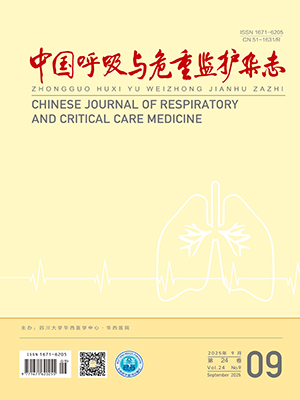| 1. |
Nordmann P, Poirel L. Epidemiology and diagnostics of carbapenem resistance in Gram-negative bacteria. Clin Infect Dis, 2019, 69(Supplement_7): S521-S528.
|
| 2. |
Mohamed A, Daef E, Nafie A, et al. Characteristics of carbapenem-resistant Gram-negative bacilli in patients with ventilator-associated pneumonia. Antibiotics (Basel), 2021, 10(11): 1325.
|
| 3. |
Temkin E, Adler A, Lerner A, et al. Carbapenem-resistant enterobacteriaceae: biology, epidemiology, and management. Ann N Y Acad Sci, 2014, 1323(1): 22-42.
|
| 4. |
王明贵. 广泛耐药革兰阴性菌感染的实验诊断、抗菌治疗及医院感染控制: 中国专家共识. 中国感染与化疗杂志, 2017, 17(1): 82-92.
|
| 5. |
刘又宁. 碳青霉烯耐药革兰阴性菌感染的治疗策略与困惑. 中华结核和呼吸杂志, 2019, 42(3): 161-163.
|
| 6. |
侯嘉, 邱洁, 郑西卫, 等. 呼吸内科病房常见革兰阴性杆菌的构成及耐药性分析. 中国呼吸与危重监护杂志, 2010, 9(1): 83-85.
|
| 7. |
Cai B, Echols R, Magee G, et al. Prevalence of carbapenem-resistant Gram-negative infections in the united states predominated by Acinetobacter baumannii and Pseudomonas aeruginosa. Open Forum Infect Dis, 2017, 4(3): ofx176.
|
| 8. |
Zhang YW, Wang Q, Yin YY, et al. Epidemiology of carbapenem-resistant Enterobacteriaceae infections: report from the China CRE Network. Antimicrob Agents Chemother, 2017, 62(2): e01882-17.
|
| 9. |
Kim T, Lee EJ, Park SY, et al. Natural prognosis of carbapenem-resistant Acinetobacter baumannii bacteremia in patients who did not receive appropriate antibiotic treatment. Medicine (Baltimore), 2018, 97(43): e12984.
|
| 10. |
谭莉, 曾莉怡, 吴健, 等. 老年患者耐碳青霉烯类鲍曼不动杆菌感染的耐药性及预后影响因素分析. 中国实用医刊, 2021, 48(1): 21-24.
|
| 11. |
Poulakou G, Lagou S, Karageorgopoulos DE, et al. New treatments of multidrug-resistant Gram-negative ventilator-associated pneumonia. Ann Transl Med, 2018, 6(21): 423.
|
| 12. |
中国碳青霉烯耐药肠杆菌科细菌感染诊治与防控专家共识编写组, 中国医药教育协会感染疾病专业委员会, 中华医学会细菌感染与耐药防控专业委员会. 中国碳青霉烯耐药肠杆菌科细菌感染诊治与防控专家共识. 中华医学杂志, 2021, 101(36): 2850-2860.
|
| 13. |
黄邵军, 袁珊珊, 成聪聪. 重症医学科鲍曼不动杆菌的耐药性及感染相关危险因素分析. 中国公共卫生管理, 2020, 36(6): 856-858.
|
| 14. |
Jorgensen SCJ, Trinh TD, Zasowski EJ, et al. Real-world experience with ceftazidime-avibactam for multidrug-resistant Gram-negative bacterial infections. Open Forum Infect Dis, 2019, 6(12): ofz522.
|
| 15. |
Rodríguez-Baño J, Gutiérrez-Gutiérrez B, Machuca I, et al. Treatment of infections caused by extended-spectrum-beta-lactamase-, AmpC-, and carbapenemase-producing Enterobacteriaceae. Clin Microbiol Rev, 2018, 31(2): e00079-17.
|
| 16. |
Igbinosa O, Dogho P, Osadiaye N. Carbapenem-resistant enterobacteriaceae: a retrospective review of treatment and outcomes in a long-term acute care hospital. Am J Infect Control, 2020, 48(1): 7-12.
|
| 17. |
袁瑾懿, 林东昉. 美国感染病学会对产超广谱β内酰胺酶肠杆菌目细菌、碳青霉烯类耐药肠杆菌目细菌和难治性耐药铜绿假单胞菌的治疗指导原则. 中国感染与化疗杂志, 2021, 21(5): 633-638.
|
| 18. |
Baraldi E, Lindahl O, Savic M, et al. Antibiotic pipeline coordinators. J Law Med Ethics, 2018, 46(S1): 25-31.
|
| 19. |
Paul M, Carrara E, Retamar P, et al. European Society of Clinical Microbiology and Infectious Diseases (ESCMID) Guidelines for the Treatment of Infections Caused by Multidrug-Resistant Gram-Negative Bacilli (Endorsed by European Society of Intensive Care Medicine). Clin Microbiol Infect, 2022, 28(4): 521-547.
|




